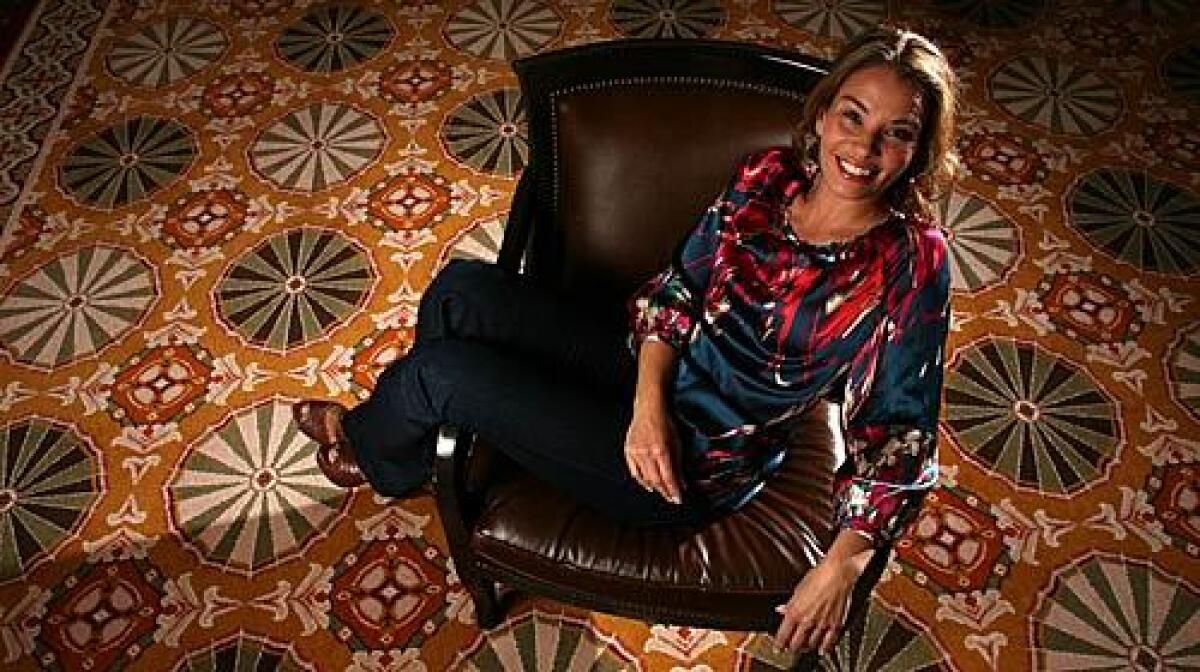That dishwasher scene in ‘Rachel Getting Married’? Inspired by real life

- Share via
“RACHEL Getting Married,” a new movie from director Jonathan Demme and starring Anne Hathaway, opened this month and quickly became a surprise hit. In the film, Hathaway plays a recovering drug addict who’s released from rehab to join her sister’s raucous Connecticut wedding.
Another surprise came for screenwriter Jenny Lumet, daughter of director Sidney Lumet, who didn’t foresee tapping into a widespread obsession with loading the dishwasher.
A crucial scene in “Rachel” involves a dishwasher-loading contest, in which the father of the bride and the bridegroom battle against the clock to discover who has the better dishwasher-loading moves. According to Jenny Lumet, the scene is based on an event she witnessed in the late 1970s, when she was 11.
The legendary, late choreographer Bob Fosse was hanging out at the Lumets’ New York apartment. “Bob was this glamorous, elegant guy,” she said. “He was dressed all in black, with his sweater over his shoulders, smoking a cigarette.” Sidney projected a different image. “My father was usually wearing a sweatsuit stained with vinaigrette.”
Fosse watched Sidney load the dishwasher. At one point Fosse said, “You know, if you put the containers from Zabar’s [the New York gourmet shop] in the top rack, you’ll have 10% more room for other stuff in the bottom.”
Sidney’s reaction came swiftly and in the form of a classic unprintable command. Jenny recalled that for the next hour, the two men loaded and unloaded the dishwasher, testing the Fosse technique for dishwasher loading.
“It was really disturbing,” she said, caught unawares by the fact that grown men could become so combative about a mundane domestic task. Who would imagine that two serious American artists could also be dishwasher geeks?
I’ve been a serious dishwasher geek for the last four years, since leaving New York, where dishwashers are a luxury, and arriving in Los Angeles, where they’re a way of life. After seeing “ Rachel Getting Married,” I immediately put the Fosse technique into practice -- with excellent results.
I have an older Maytag, not an upscale Miele or Bosch, but the numerous special features and refinements to be found on pricey dishwashers (a top-of-the-line Miele costs more than $2,000) have little effect on loading technique.
I’m not alone. At the Trader Joe’s in Eagle Rock, caterer Sjaan Trowbridge confessed happily to being “very methodical” about loading her dishwasher. “I had to work it out over time,” she said. “You have to get in the max.” If anything, her approach is more elaborate than the Fosse technique. It involves dedicated locations for glasses, Tupperware and even long knives and spatulas.
The preoccupation with how and how not to load is so pervasive that it has engendered a backlash. At the Whole Foods Market in Glendale, commercial director Tom Barron of Castaic said that he had opted out of the whole dishwasher geek hustle. He doesn’t own a dishwasher and, in all likelihood, never will. “There’s too much management, too much arranging. It’s stressful to move the stuff around.”
Manufacturers are reluctant to go on record telling customers exactly how to load dishwashers (if you bought it, you should be able to load it however you want, within reason). Consumer Reports isn’t: On its website it provides a six-step guide that goes beyond the Fosse technique in terms of advice about how to position specific items.
In response to inquiries, however, General Electric sent me an owner’s manual for its current Profile line of dishwashers. There on Page 14 are instructions for getting 12 place settings into the upper and lower racks. Bob Fosse would be delighted; Sidney Lumet would growl.
Lumet’s basic problem was that he thought the upper rack was mainly for cups and glasses and that the lower rack was for plates and bowls. Fosse’s revelation was that you can also place any shallow, bowl-like item in the upper rack, thereby creating more vertical space in the lower racks for plates, platters and so on to be washed on their sides.
The next generation
DISHWASHERS were far less complex in those days. Now, a major epiphany for many dishwasher geeks is that they can reconfigure their racks to completely violate whatever alleged loading wisdom they may have received.
“Adjustability and flexibility are things that consumers respond to,” said Paul Riley, GE’s marketing manager for dishwashers. There are a lot of dishwasher choices out there, and Riley indicated that manufacturers like GE are constantly checking customer preferences and needs. “We’re evaluating our designs all the time.”
Riley said the next generation of dishwashers would tackle the dirty dishes people “would like to wash, but are afraid to wash.” Even the most hard-core dishwasher geek turns to scrubbing pads and the sink when confronted with eggs, rice and oatmeal. But, according to Riley, that terrible trio has been placed on notice.
Josephine Cochrane, who devised the modern dishwasher in the late 1800s (she was a plucky woman of leisure whose grandfather had demonstrated the first functional steamboat in America), would probably be shocked at the conflicts her innovation has spawned.
In my own clan, I incessantly demand that my wife (and her mother and father) refrain from putting the forks in the dishwasher tines up and the knives in blades up. The manufacturers back me up on this, but I’ve nevertheless shed blood on several occasions because of the flawed belief that the jets will not get to the dirty cutlery if the business ends are inside the basket.
Luckily, I’ve never had a fight about dishwasher custody. But plenty of other couples have. In the Wall Street Journal’s the Juggle blog, Stefanie Ilgenfritz recently wrote that “in many families the dishwasher becomes a stainless-steel-and-ceramic metaphor for marital power.”
Josef Komenda, a Web developer in Carrboro, N.C., has an essay titled “The Dishwasher Incident” on his website, Komejo.com. Loading the dishwasher, he writes, was “the first episode in my marriage that caused dissent between my wife and myself.”
“She had finished loading, and there were some dishes left over,” Komenda said in a phone interview from his home. So he analyzed the contents of the dishwasher and figured out how to get the extra dishes in. “She saw what I had done, and I got busted.” For what it’s worth, Komenda is no longer married, but he said that the dishwasher incident had nothing to do with his divorce.
Almost everyone I have spoken with about being a dishwasher geek has professed strong feelings about this commonplace machine’s ability to offer a peculiar window into the soul. Do you overload or underload? Would you ever consider putting a cookie sheet in the dishwasher? Do you separate your cutlery by type, or do you just throw it all in?
Unlike Jenny Lumet, who said she’d told her childhood dishwasher story only once before it was in the movie, I was not surprised by a dishwasher-loading contest. I’ve been waiting to see dishwasher geeks outed for a long time.
More to Read
Sign up for Essential California
The most important California stories and recommendations in your inbox every morning.
You may occasionally receive promotional content from the Los Angeles Times.










